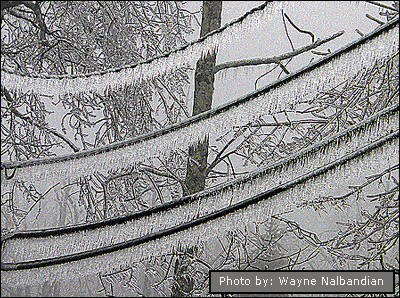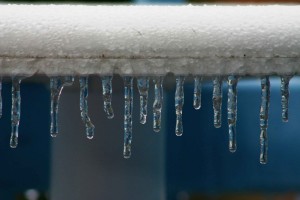Here is a great article from The Weather Channel. Cold weather will cause some trees to explode by freezing the sap, because it contains water, which expands as it freezes, creating a sound like a gunshot. The sound is produced as the tree bark splits, with the wood contracting as the sap expands(Wikipedia). Also, A 1/2-inch accumulation on power lines can add 500 pounds of extra weight. In this article, Chris Dolce explains the difference between a nuisance ice storm, a disruptive ice storm and a crippling ice storm and also gives us tips on how to prepare for the cold weather and how to prepare for power outages. ServiceMaster hope all of you take his advice and stay safe!
With a significant winter storm predicted to bring snow and more than an inch of ice to parts of Georgia, the Georgia Emergency Management Agency/Homeland Security (GEMA) is encouraging all residents to stay off the roads and prepare for extended power outages.
Even a thin coating of ice can result in a travel nightmare, while heavier amounts will severely damage trees and power lines. Strong winds can add extra force to already weighed down tree branches and power lines, increasing the likelihood of significant damage.
(WEATHER READY: Winter Storm Safety)
Ice Storm Facts
These ice accumulations are caused by freezing rain. Freezing rain is a result of snow falling through an above-freezing warm layer in the atmosphere above the surface of the earth, which melts the snowflakes into rain. The rain drops then move into a thin layer of below-freezing air right near the surface of the earth, allowing them to freeze on contact to the ground, trees, cars and other objects.
(MORE: Difference Between Freezing Rain and Sleet) 
What kind of damage do different amounts of ice cause? Below we define the impacts of nuisance, disruptive and crippling ice storm events.
Nuisance Ice Storm
A nuisance event is usually one of less than a 1/4 inch of ice.
Even though these lighter accumulations are considered a nuisance, travel can be extremely dangerous even with a light glazing.
Disruptive Ice Storm
A disruptive ice storm is typically one of 1/4 to 1/2 inch of ice accumulation.
This amount of ice starts to damage trees and power lines.
Crippling Ice Storm
Widespread accumulations of over 1/2 inch.
With this much ice there is severe tree damage and power outages may last for days.
The most devastating storms contain ice accumulations of an inch or more.
(MORE: Winter Storm Central) 
Be Prepared
- Avoid driving on icy roads for your safety and the safety of emergency personnel.
- Be sure to charge cell phones and laptops ahead of time. Make sure you have several ways to communicate with others. Consider landline phones, social media, and texting.
- Remember, if it’s too cold for you, it’s too cold for your pets. Plan for pets to come inside, and store adequate food and water for them.
- Children should never play around ice-covered trees; they may be injured if a branch breaks under the weight of the ice and falls on them.
- Think about safe alternate power sources you could use if you lose heat, such as a fireplace, wood/coal stove or portable space heaters. However, be sure to exercise caution:
- Follow manufacturers instructions when using portable space heaters and other devices.
- Never use portable generators, camp stoves and grills inside your home or garage; they should only be used outside. Keep them at least 20 feet away from your home’s windows, doors and vents to prevent deadly carbon monoxide poisoning.
- Use flashlights during power outages instead of candles to prevent the risk of fire, and keep plenty of extra batteries on-hand.
Before the Power Goes Out: Food Safety
- Make sure you have appliance thermometers in your refrigerator and freezer.
- Check to ensure that the freezer temperature is at or below 0 degrees and the refrigerator is at or below 40 degrees.
- In case of a power outage, the appliance thermometers will indicate the temperatures in the refrigerator and freezer to help you determine if the food is safe.
- Freeze containers of water for ice to help keep food cold in the freezer, refrigerator, or coolers in case the power goes out. If your normal water supply is contaminated or unavailable, the melting ice will also supply drinking water.
- Have coolers on hand to keep refrigerated food cold if the power will be out for more than four hours.
- Purchase or make ice cubes in advance and store in the freezer for use in the refrigerator or in a cooler. Freeze gel packs ahead of time for use in coolers.
- Store food on shelves that will be safely out of the way of contaminated water in case of flooding.
When the Power Goes Out: Food Safety
- Keep the refrigerator and freezer doors closed as much as possible to maintain the cold temperature.
- The refrigerator will keep food cold for about 4 hours if it is unopened.
- A full freezer will keep the temperature for approximately 48 hours (24 hours if it is half full) if it is unopened.
- Buy dry or block ice (or freeze containers of water) to keep the refrigerator as cold as possible if the power is going to be out for a prolonged period of time.
- If you plan to eat refrigerated or frozen meat, poultry, fish or eggs while it is still at safe temperatures, it’s important that each item is thoroughly cooked to the proper temperature to assure that any foodborne bacteria that may be present is destroyed. However, if at any point the food was above 40 degrees for two hours or more — discard it.
- For infants, try to use prepared, canned baby formula that requires no added water. When using concentrated or powdered formulas, prepare with bottled water if the local water source is potentially contaminated.

